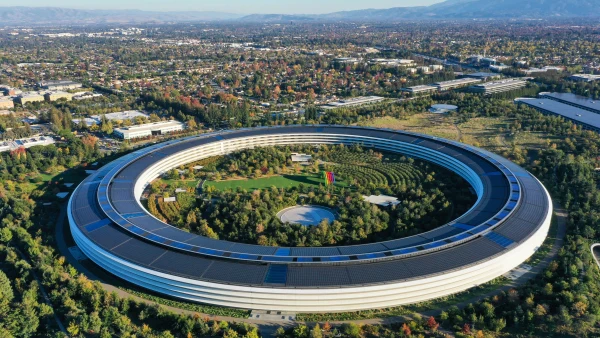THE APPLE PARK: The 21st Century Workplace

Did you know that the Apple Park, which is a concept of Steve Jobs' ideal working environment, houses more than 12,000 employees, and that the project took five years to complete?
The Apple Park is the corporate headquarters of Apple Inc., the multinational corporation and technology company headquartered in Silicon Valley, Cupertino, California in the United States of America. Apple Inc. designs, develops, and sells consumer electronics, computer software, and online services. Its devices include the iPhone, iPad, Mac, Apple Watch, Vision Pro, and Apple TV; operating systems include iOS, iPadOS, and macOS; and software applications and services include iTunes, iCloud, Apple Music, and Apple TV+.
Also known as Apple Campus 2, the Apple Park, located on a suburban site totaling 1.46 km2 (360 acres), was opened to employees in April 2017, while construction was still underway, and superseded Apple Campus as the company's corporate headquarters, which opened in 1993. The main building's scale and circular groundscraper design, by Norman Foster, have earned the structure the media nickname "the spaceship".
The Apple Park houses more than 12,000 employees in one central four-story circular building of approximately 0.26 km2 (64 acres). Apple co-founder Steve Jobs wanted the campus to look less like a business park and more like a nature refuge; 80 percent of the site consists of green space planted with drought-resistant trees and plants indigenous to the Cupertino area, and the center courtyard of the main building features an artificial pond.
The history of the birthing of the Apple Park began in April 2006, when Apple's then CEO Steve Jobs announced to the city council of Cupertino that Apple had acquired nine contiguous properties to build a second campus, the Apple Campus 2. The idea for a new headquarters was conceived by Jobs and Apple's then chief designer Jony Ive. Ive was Apple's immediate choice to design the project, going on to work very closely together with Norman Foster across five years, designing every detail, from the glass panels to the elevator buttons.

Purchases of the needed properties were made through the company Hines Interests, which in at least some cases did not disclose the fact that Apple was the ultimate buyer. Philip Mahoney, a partner with a local commercial real estate brokerage, noted that this is common practice in attempts to arrange the purchase of contiguous land made up of multiple parcels with separate owners, in order to keep costs from skyrocketing and not reveal the company's plans to competitors. Among the sellers of the properties were SummerHill Homes (a plot of 8 acres or 3.2 hectares) and Hewlett-Packard (three buildings of their campus in Cupertino).
Until April 2008, Apple had not sought the necessary permits to begin construction, so it was estimated that the project would not be ready in 2010 as originally proposed; however, the buildings on the site were held by Apple for its operations. In November 2010 the San Jose Mercury News revealed that Apple had bought an additional 98 acres (40 ha) no longer used by HP Inc., just north across Pruneridge Ave. This space had been the HP campus in Cupertino before it was relocated to Palo Alto.
On June 7, 2011, Jobs presented to the Cupertino City Council details of the architectural design of the new buildings and their surroundings. He did not live to see construction begin, dying a few months later on October 5. On October 15, 2013, Cupertino City Council unanimously approved Apple's plans for the new campus after a six-hour debate. Shortly thereafter, demolition work began to prepare the site for construction.
The Apple Park's facilities consist of seven cafés with the largest being a three-level café for 3,000 sitting people; an underground 1,000-seat auditorium intended for Apple product launches and press meets; a 100,000-square-foot (9,300 m²) fitness center, a research and development facilities that feature two large 300,000-square-foot (28,000 m²) buildings on the southern edge of the campus and are occupied by more than 2,000 people; an Apple Park Visitor Center which is a two-story 20,135 sq ft (1,870.6 m²) structure with four main areas, and an Apple Park Developer Center which is a two-story structure across the street from the Apple Park Visitor Center.
Originally expected to break ground in 2013 and open in 2015, the project was delayed and started in 2014. On February 22, 2017, Apple announced the official name of the campus as the "Apple Park", and the auditorium to be named the "Steve Jobs Theater". The campus opened for workers in April 2017, despite continued construction work. This was followed by the first event in the Steve Jobs Theater, which took place on September 12, 2017. The Apple Park Visitor Center opened five days later, on September 17, 2017.
As a consequence of the presence of the Apple Park in the area, surrounding streets have met with both increased tourism, along with rising real estate values of local housing, often drawing in Apple employees wanting to live near the workplace.
Source: Wikipedia
#penglobalbusiness #ApplePark



